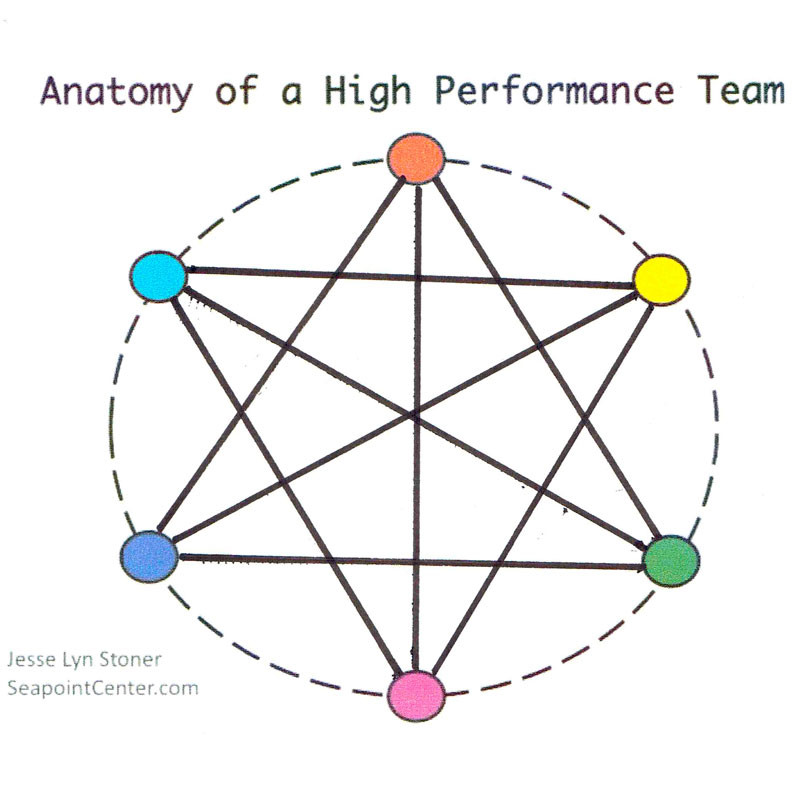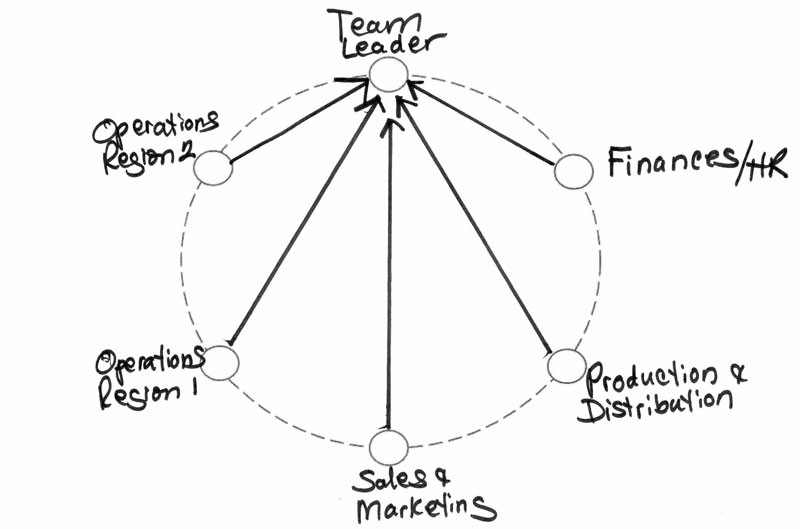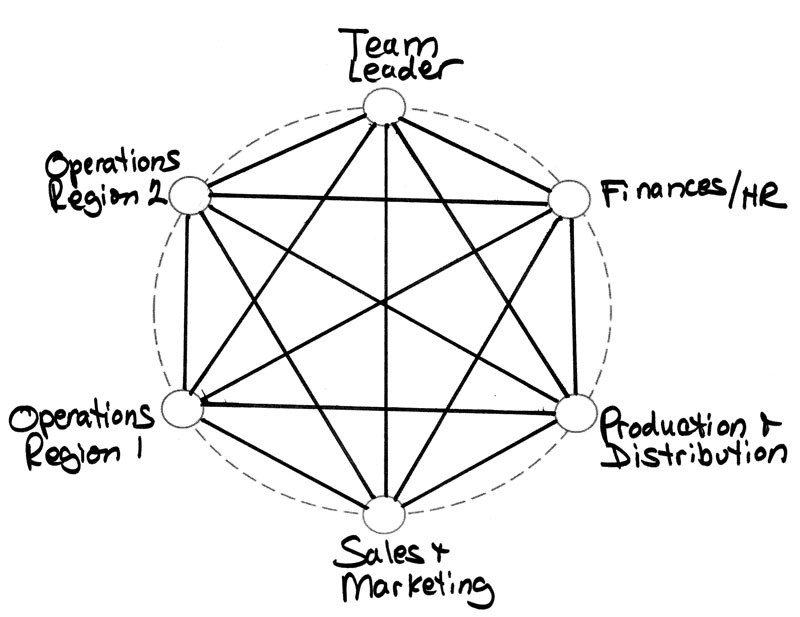 What is a high performance team? –> a team that produces outstanding results, where everyone works in synchronicity, appreciates each other’s contributions, and is proud to be a member of the team.
What is a high performance team? –> a team that produces outstanding results, where everyone works in synchronicity, appreciates each other’s contributions, and is proud to be a member of the team.
Research has revealed the characteristics of high performance teams. And most of us have had an experience on a high performance team at some point in our lives – whether at work, in school, sports or our community.
We know what they are, we know they are powerful, we would like to be a member of one.
Yet, high performance team leadership is elusive. Although most leaders will say they want their team to be high performance, most teams are not.
How do you build a high performance team?
Actually you can’t. Here’s why.
You can build a good team, but if you want a great team, you will eventually need to stop building, hand over the reins, and let the team build itself.
You must be willing to let go of control and share leadership. Otherwise the team will remain dependent on you to provide leadership, unable to move to the next level.
Leadership is fluid on high performance teams. It emerges from within the team, depending on what is required at the moment, who has the needed skills and who is motivated to provide leadership.
You might not be able to build a high performance team, but you can create the conditions that will shift the flow of energy and propel your team to transform itself.
Three Steps to Propel Your Team to High Performance
High performance team leadership is about supporting team development, not just team accomplishment.
It’s about helping the team solidify and learn to build itself so it can transform from good to great.
1. Make sure your “team” is really a team. Establish a unifying purpose.
A team is different from a collection of individuals who report to the same person.
In my post Are You a Team In Name Only? I define team as:
A group of people with a shared purpose, who are interdependent in achieving it, have access to each other in order to communicate and coordinate, and are mutually accountable.
A diagram of the focus and flow of energy on a functionally-oriented “leadership team” looks something like this.
 Because there is no unifying purpose or overarching goal, each individual’s focus is on their own functional area.
Because there is no unifying purpose or overarching goal, each individual’s focus is on their own functional area.
Team meetings consist mostly of functional updates. Conversations are primarily between the functional head and the leader. There is little need for whole group discussion or decision-making.
Don’t assume everyone understands your team’s purpose just because you do. Hold a team discussion to make sure everyone agrees on what the purpose is and believes it is worthwhile.
Below is a diagram of a leadership team that agrees their purpose is “using our collective wisdom to provide leadership for the entire department.”

Although they still have individual functional responsibilities, they have an additional collective responsibility. Team members are connected around their shared purpose.
However, the team is still dependent on the formal leader for coordinating activities and ensuring work is accomplished.
So although the purpose now in the center, where it belongs, the focus and energy still flows in the direction of the leader.
2. Build “team competencies.”
The way to open up the flow of energy is to build “team competencies.”
Although team members might be competent in their individual functional roles, they still need to develop the ability to work together as a team. And even if they have been successful on other teams, they still need to learn to work together on this team.
Team competencies include the ability to:
- Communicate clearly and effectively with each other, to give and receive feedback.
- Maximize the benefits of diversity on the team.
- Surface and resolve conflict.
- Make good decisions that are supported by all.
As your team develops the ability to make team decisions and communicate effectively as a team, the team’s focus and flow of energy begins to look like this.

High performance team leadership shifts the flow of team energy from a leader-focus to a team-focus.
3. Step out of the way and allow the team to assume responsibility for its functioning.
At this point, the team has the competency to transform itself. Now your role is to serve as a resource to the team and as a liaison (and shield if necessary) to the rest of the organization.
Focus on providing support as needed:
- Providing resources.
- Removing organizational roadblocks.
- Communicating organizational priorities and any shifts in strategy, structure, or processes.
- Celebrating team success.
—————————————————————————————–
* Footnote
How to chart the focus and flow of energy on your own team.
A powerful and informative activity is to diagram the energy and focus on your own team. During a team discussion, observe who people are looking at while they speak. On a piece of paper, map where each person is sitting. Each time someone speaks, draw an arrow pointing toward the person they are speaking to or looking at. After 15 minutes, look at the overall pattern of your diagram. Then share your drawing with your team. Let them interpret it. I guarantee it will be an interesting discussion.













Love the diagrams, Jesse. They really drive the point home.
I want to try this activity with my team, but not sure how to introduce it. Any advice?
Glad to hear you found the diagrams helpful, James. If this is the first time they are having a discussion about their team functioning, I’d suggest you share this article with them and start with a discussion about the value of looking at their team functioning. Another thing they could look at is The 12 Team Behaviors That Drive Team Performance to see whether these are in place. (Each person doesn’t need to supply all of them, but if some are missing, the team will be out of balance and should think of ways to compensate.)
As usual, this blog post is so on-point. When I see the emails announcing the new posts, I typically consider what I hope to read about and how I might answer the questions frequently included – before proceeding to the full post. For this one, I believed the key was to facilitate the team’s working to get better! In 29+ years of teaching, every class had randomly selected teams! My first charge to every team was to develop a Team Performance Agreement or TPC – essentially a contract among team members outlining how they would work together. It evolved from the late Stephen Covey’s writing. They were reminded it was a dynamic guide – needing reviewing and likely updating as they worked together. Quite predictably, the best teams took this quite seriously; and the poorest teams didn’t, often remarking they should have given the TPC more consideration.
Your first paragraph (“What is a high performance team? –> a team that produces outstanding results, where everyone works in synchronicity, appreciates each other’s contributions, and is proud to be a member of the team.”) is terrific. There’s much about what you wrote that I found stimulating but I’ll mention only one: the use of ‘synchronicity’. As I frequently do, I used my capability to get the definition without leaving the post: simultaneous occurrence of events that appear significantly related but have no causal connection. Yes, they occur at the same time, are very related to each other, but not done together! There are gains from diversity that improve things if everyone works on a task together; but the real advantage is when each member knows and discusses others’ efforts while concentrating on getting the best outcome for her/his task. Synchronicity is working together but working together does not insure synchronicity!!!
I will be Considering this blog post further and quoting from it frequently I’m absolutely certain!!!
I provided a definition because I wasn’t able to find a clear, crisp definition when I did a search. Glad to hear that mine worked for you. One of the biggest problems for teams is lack of clear agreements. I agree that a clear written agreement, updated as changes occur, is essential for every stage of a team’s life cycle. You might enjoy my blog post Create a Team Charter to Go Faster and Smarter. Thanks for the definition of synchronicity. It confirms what I wanted to convey. Love this: “Synchronicity is working together but working together does not insure synchronicity.” Appreciate your insights, John.
This line says it all: You can build a good team, but if you want a great team, you will eventually need to stop building, hand over the reins, and let the team build itself. One element I might add is that the team collaborates on an agreement as to what behaviors will support team cohesiveness and results. As always, a great post.
One of the most important tasks the team needs to do! Much thanks for adding to the conversation, Eileen.